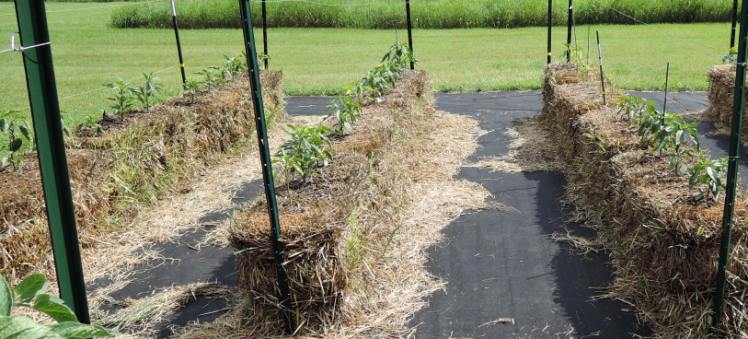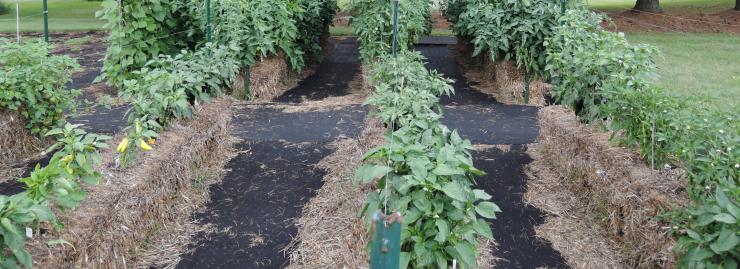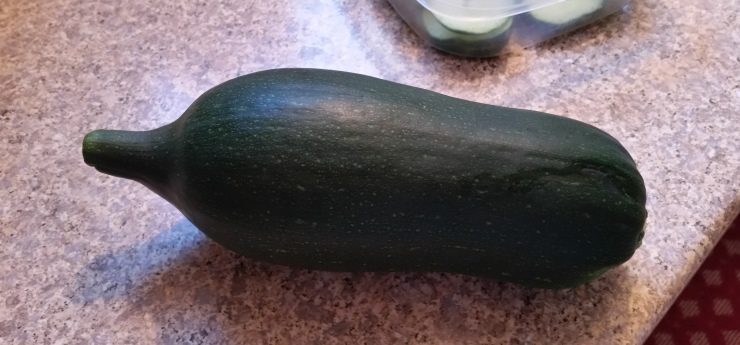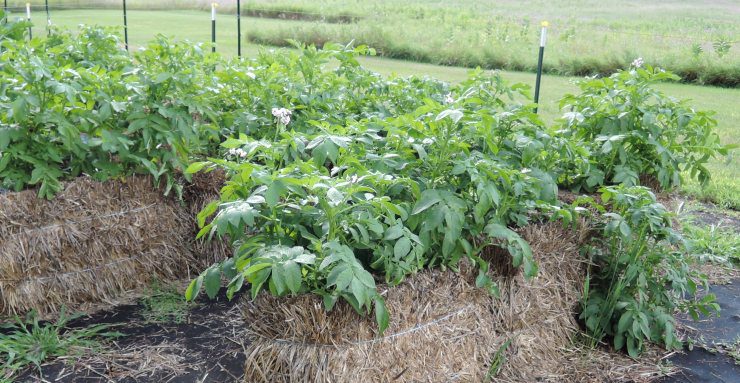Things are looking pretty good out there now that we’re almost into mid-August. Straw bale gardening has presented me with challenges just as much as it’s been amazing despite chilly nights all summer, and except for one 10-day stretch of hot days, the average temp this year has been around 74 degrees F. Still the heat in the bales has improved the growth rate for this environment.
Dealing with all that wheat sprouting in the bales turned out to be not such a problem after all. It’s pretty easy to pull once the stems get a bit tougher, though I never did find time to pull it all. I just did the tops a bit at a time as I was watering, and most of what I didn’t get pulled died off by mid-July.
Awesome!
But this is a signal, though what it meant didn’t register in the beginning. What yellowing, then declining wheat means is that the decomposing straw has taken over all available nutrients in the bales to help itself break down. This translates into your veggie plants also not having what they need. Those anemic pepper plants I bought to replace what the wind broke just weren’t coming around like they would have in the ground. Blossom end rot on the zucchini showed up on the first fruits, and chloritic leaves on my healthy homegrown pepper plants pointed out a lack of calcium, and perhaps iron. Cured the peppers with Epsom salt spray and watering them with some chelated iron, but the zucchini still had some affected fruits.
About the 1st of July I realized we needed some fertilizer, though it puzzles me still why the tomatoes were not affected like all these other plants were. My guess is that they rooted into the ground beneath the bales pretty quickly, because they have to develop a sizable root system to support all that plant soon to appear on top, which gave them some naturally present nutrients. With so many bales to feed, I knew it wasn’t feasible to use hydro nutes out here. It’s simply too costly in this situation. You can’t really ‘work in’ something granular like Happy Frog either. It’s not dirt, and the less disturbance the packed straw gets, the better. Hmmm…
Definitely have to use a liquid that includes these missing micronutrients too. I had only small town hardware store selections to pick from since I needed it immediately, and so I’m using Miracle Gro Tomato Fertilizer on everything. Most of the purchased plants turned around quickly, and are doing great. But not this weird zucchini (variety unknown), and not those anemic pepper plants either. In the end I could care less about those scrawny peppers, because they’re not the jalapenos I needed – they’re growing yellow banana pepper fruits! It’s really irritating how many plants in garden centers are incorrectly labeled! No, it’s not a case of someone switching one tag. The entire flat, fresh off the truck, was labeled the same.

Mid June

Early August
The blossom end rot on the zucchini is a well known issue, but I don’t understand how they’re growing! Starts off normal, then a big bulge forms on the stem end, followed by another in the middle, and the blossom end stays thin. They’re massive with almost no seeds in 3-4 days flat from starting that bulbous end. Taste fine, a lot crunchier than normal too. Variety or some growing issue?

There will be no more purchased veggie plants in my garden in years to come, not if I can help it. They’re just not worth the time, effort or money. Time to grow extras so I can at least start off with strong plants that are more likely to be what the seed packet said.
When the potatoes finally popped up on the tops of the bales it was super exciting. Really had my doubts when I was sticking the seed potatoes in the bottom of the bales, but hey, its all part of the adventure. Always interesting to see what happens in the end. The smallest of the seeds I put all in one bale to keep track of whether the size of what you start with affects the potato size you harvest. The plants are a bit smaller, but have to wait and see on the tubers. Yukon Golds are fast to mature, but they’re not ready yet, and there’s no peeking at the progress growing in bales like this.

ANTICIPATION……..
Teaching Old Dogs New Tricks
All that work getting the straw bales conditioned for planting in May was definitely worth it. Showing up that opinionated farm boy that lives next door is never easy, but 5-foot tall tomato plants by the 1st week of August in this climate sure has him all excited. So much for Dad’s belief that I’d gone off the deep end. Now he’s sending people for garden tours. A feather in my cap, he’s impressed 😀

Holy Cow! Running out of support already.
The cool nights aren’t helping the tomatoes ripen quickly, and after a warm day this causes fog to form down the slope from my garden. Many nights it settles into the entire patch too, which triggers blight. So, on top of the endless stringing of tomato branches, I’ve been spraying Serenade for a month. As long as I can keep the omnipresent disease from taking over, and frost holds off til at least mid-October, I should have a bumper crop of tomatoes. The huge plants are laden with fruit and there’s a bazillion flowers in there too. The 55-day Sasha Altai plants just started ripening last weekend – which means they’re delayed in finishing by at least 2 weeks despite planting 2 weeks earlier than normal, and trying out Tomato Blossom Set… a story unto itself. Be sure to catch next week’s post in Nutrients about that.
While anyone south of the 45th Parallel might think my straw bale gardening results aren’t that great, it’s very impressive for my New Siberia climate. Yes, you might detect some mildew on the older leaves of my cucumber. It’s all this fog and it’s at the bottom of the garden in that hole. Fine by me, who needs an overload of fresh cukes all at once? A couple a week is plenty, and it’s fulfilling it’s duty as is. The bell pepper plants aren’t doing that well, but I think it’s due to the nutrient issues earlier in the season. They’re also setting a few feet lower into this valley that fills up with clouds so often. They get socked in by fog many nights – more often than the tomatoes up on top.
Seriously considering relocating the garden now that I don’t need the manure enriched soil available only in the old cow pen. Straw bale gardening means I don’t have to worry about the ground soil so much, and here it’s pretty much lake sand. Anything to stop the damn fog.